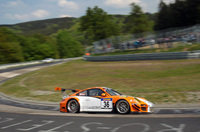911 GT3 R Hybrid heads Porsche entry at Nürburging 24 Hours

Porsche will enter the Nürburgring 24 Hours race in Germany this weekend (25/26 June) with a further developed version of the 911 GT3 R Hybrid, following a successful test in the Nürburgring Long Distance Championship (VLN) that saw the car score the first race win for a Hybrid-Porsche in May.
Designed and built by Porsche at its Research and Development department in Weissach, Germany, the 911 GT3 R Hybrid led the gruelling 24 hour race for eight hours last year. The performance of the innovative race car clearly proved that the hybrid technology developed by Porsche is very competitive in racing while also offering considerably lower fuel consumption.
For this year’s Nürburgring 24 hour race, however, the 911 GT3 R Hybrid has been substantially reined in by the organisers. After the latest re-classification, the combustion engine now produces only 448 hp. Calculated over one lap, the 2011 edition of the car now delivers a lower system output than last year’s vehicle with a combustion engine.
Sharing the cockpit of the 911 GT3 R Hybrid at the Nürburgring are factory race drivers Jörg Bergmeister (Germany), Richard Lietz (Austria), Patrick Long (USA) and Marco Holzer (Germany), who were all deeply involved in the vehicle development.
911 GT3 R Hybrid ‘Version 2.0’
Priority of the development for the 2011 ‘Version 2.0’ was given to the further improvement of efficiency through the targeted optimisation of the hybrid components, which also resulted in a 20 per cent reduction in overall weight. As a consequence, the 911 GT3 R Hybrid is intended to achieve the same lap times as its predecessor, but with less fuel consumption.
The general layout of the 911 GT3 R Hybrid was adopted from the 2010 model. A portal axle with two electric motors drives the front wheels and supplements the four-litre six-cylinder ‘boxer’ engine at the rear, which now delivers 448 hp after its re-classification by the race organisers.
Compared to the 2010 model, the output of both electric motors has been increased from 60 to 75 kilowatts each. For seconds at a time, the drivers have almost 200 additional horsepower driving the front wheels. Depending on the programming, this power is automatically activated through use of the throttle pedal. Moreover, drivers can manually call up this extra power, for instance when overtaking.
Electric flywheel generator
The front axle motors are powered via an electric flywheel accumulator, which is housed together with the other hybrid components in a carbon fibre safety cell inside the cockpit on the passenger’s side. The flywheel rotor spins up to 40,000 rpm and stores energy mechanically as kinetic, or rotational, energy.
The flywheel generator is charged-up whenever the driver applies the brakes, with the two electric motors reversing their function on the front axle and acting themselves as generators. Energy formerly converted into heat, and thus wasted, upon every application of the brakes is now converted highly efficiently into additional drive power.
Depending on racing conditions, hybrid drive is used in this case not only for extra power, but also to save fuel. This again increases the efficiency and, accordingly, the performance of the 911 GT3 R Hybrid, by making pit stops less frequent.
At first glance, the new GT3 R Hybrid is clearly distinguishable from the 2010 model. Thanks to the optimisation of the hybrid system’s high voltage components, the large louvres in front of the rear wheelarches were no longer necessary. This reduces aerodynamic drag and also lowers fuel consumption. All in all, the weight of the vehicle has decreased from 1,350 to 1,300 kilogrammes.
The cockpit of the 911 GT3 R Hybrid has also been completely revised. Most of the displays and controls have moved to the steering wheel. Drivers can operate the rest of the functions via backlit buttons now situated on the centre console. Priority was placed on the ergonomics and the clear layout for drivers; always a priority but particularly significant when racing in darkness.
Porsche team overview
The Manthey Racing team fields two examples of the Porsche 911 – a GT3 R and a GT3 RSR – each sporting a prominent yellow-green design. Manning both vehicles is the winning Porsche factory driver quartet, Timo Bernhard (Germany), Romain Dumas (France), Marc Lieb (Germany) and Manthey driver Lucas Luhr (Switzerland).
Another Porsche factory driver, Wolf Henzler (Germany), is competing for the Falken Motorsport team in a 911 GT3 R. His teammates are Martin Ragginger (Austria), Peter Dumbreck (GB) and Sebastian Asch (Germany). Also hoping for a top result is the Haribo Manthey Racing line-up of Richard Westbrook (GB), Christian Menzel (Germany), Mike Stursberg (Germany) and Hans Guido Riegel (Germany). And with its all-German crew of Georg Weiss, Oliver Kainz, Michael Jacobs and Jochen Krumbach, the Wochenspiegel Team Manthey has proven Nordschleife specialists at the wheel of its 911 GT3 RSR.
Follow the Nürburgring 24 Hours race on Porsche Origin
News and films from the Nürburgring 24 Hours, and the Porsche Carrera World Cup that takes place around the Nordschleife beforehand, will be updated on Porsche Origin in the build-up to the race and over the weekend.

